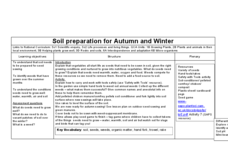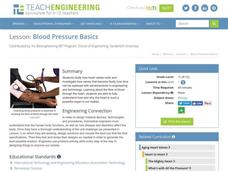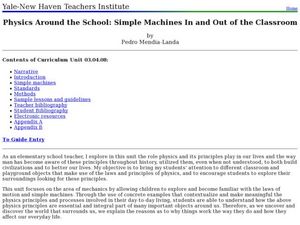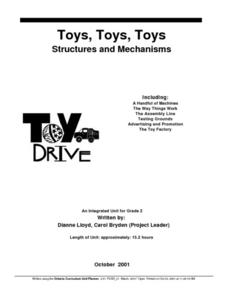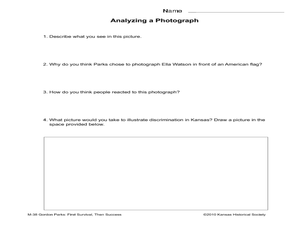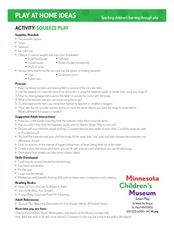Curated OER
Health Education: An Integrated Approach; A Day Without Sight
Fourth graders hypothesize about the difficulties they may encounter if they did not have their sense of sight, in order to establish a sense of empathy for the disabled. In this lesson on senses, 4th graders record all of the things...
Curated OER
Total English Upper Intermediate: Obligations and Explanations
In this expressing obligations and can do statements, students correct the mistakes in 8 sentences and then choose 2 items listed and explain how to do them.
ARKive
Marvellous Mini-beasts – Design a Species
Here is a creative activity that teaches kids how species evolve different characteristics for survival. The lesson begins as the class discusses and examines the adaptive traits of mini-beasts or insects. Then, in small groups, they...
Curated OER
The Earth's Magnetic Field
Students explain how the earth's magnetic field works and looks. They create
their own free-floating compass using the everyday materials. After constructing their compass, they test it and determine north.
Curated OER
Soil Preparation for Autumn and Winter
Students determine how and why soil needs to be prepared for the fall and winter seasons. In this agriculture lesson, students determine how to use gardening tools safely. They show how to work with compost material and fertilizer to...
Curated OER
Uses of Minerals
In this minerals worksheet, students read an excerpt about gold and then respond to the questions that follow. They explain how the weight of gold affected the history of some western states and why gold is expensive.
Curated OER
John Muir Nature Journal
Students explain how John Muir carefully and quietly observed nature and record his observations in his journal with writings and drawings. Students create their own nature observation journal.
Teach Engineering
Blood Pressure Basics
Under pressure! The second lesson of the series introduces the class to blood pressure and the impact of high blood pressure on the cardiovascular system. It helps learners make the connection between blood pressure and how the heart...
Curated OER
Physics Around the School: Simple Machines In and Out of the Classroom
Students explore different machines and the components that encompass the science of physics. In this physics lesson students explore how things move.
Curated OER
One Step At a Time
Young scholars examine cultures in Africa. They discover culture includes behaviors, customs and actions. They examine how different people interpret things differently and practice seeing a situation from two points of view.
Inside Mathematics
Magic Squares
Prompt scholars to complete a magic square using only variables. Then they can attempt to solve a numerical magic square using algebra.
Curated OER
Toys, Toys, Toys: Structures and Mechanisms
Second graders continue their examination of how things operate. In groups, they use this information to create a simple toy of their own. They also explain the relationship between stationary and moving objects and share their simple...
Curated OER
Show And Tell
Have you ever saved your money to buy something you really wanted? Elementary schoolers share how they saved their money for things they wanted, and they bring in one or two items that they bought with their personal savings.
E Reading Worksheets
Tone Worksheet 3
The interpretation of a poem often lies in the mind of its reader, especially when reading the tone. Focus on author's word choice, middle schoolers read four different poems and briefly state a perceived tone for each, along with the...
Bowland
Public Transport
"Statistics is the grammar of science" -Karl Pearson. In the assessment task, learners read a claim made by a newspaper and analyze its conclusions. They need to think about the sample and the wording of the given statistics.
Curated OER
Gordon Parks:First Survival, Then Success
Have your class examine the work of Gordan Parks. They determine how Park's childhood in Kansas inspired his artwork as they analyze his writings and photographs. Young scholars complete the provided worksheets as they compare, contrast,...
Virginia Polytechnic Institute and State University
Lesson Plan: Omelet Cooking Principles
Although designed for a foods lab, the information in this resource might be just the thing for your own recipe notebook. Illustrated, step-by-step directions for making the perfect omelet, egg-citing puzzles, games, and even...
Curated OER
Invisible Life
By setting up an aquarium in the classroom, learners are able to describe some macroscopic and microscopic organisms that are found inside. This well-designed, and educationally rich lesson requires pupils to use microscopes to view...
National Endowment for the Humanities
The "To Do List" of the Continental Congress
What is on your to-do list today? The second lesson plan of a three-part series on Lost Heroes of America investigates the laundry list of items in front of the second Continental Congress. Scholars research, analyze, and present...
Curated OER
Rooftop Gardens
Second graders investigate how to help a city building remain cooler on the inside. They create a rooftop garden in order to shield the building and lower the internal temperature. The garden is meant to replace the black tar paper that...
Curated OER
Squeeze Play
Young scientists demonstrate how to move objects. In this fine motor activity, students use various objects such as dice, erasers, and soft balls and move them using the proper device.
Curated OER
Friendship Salad
What goes into a friendship salad? Kids find out as they create a fruit salad made of all the important parts of a successful classroom (helpers, listeners, hard workers, sharing, and encouraging words). Don't let that rotten banana in,...
TED-Ed
What is the World Wide Web?
Did you know that the World Wide Web and the Internet are not the same thing? Did you know that Tim Berners-Lee is considered the father of the Web? Networks, web servers, web hosts, website addresses, domain names, web languages,...
Turabian Teacher Collaborative
Introductions: Formulating Problem Statements
Describing a problem efficiently doesn't solve it, but a well-crafted argument can move readers to action. High schoolers focus on structuring problem statements by reading examples of strong essays and working in groups to create their...






